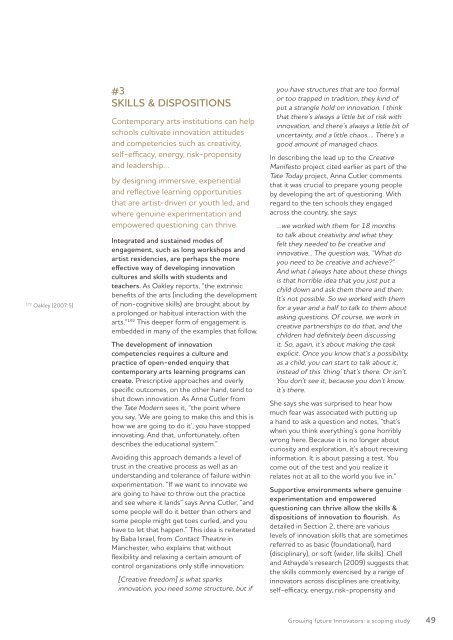GrowinG Future innovators - ARC Centre of Excellence for Creative ...
GrowinG Future innovators - ARC Centre of Excellence for Creative ...
GrowinG Future innovators - ARC Centre of Excellence for Creative ...
You also want an ePaper? Increase the reach of your titles
YUMPU automatically turns print PDFs into web optimized ePapers that Google loves.
172 Oakley (2007:5)<br />
#3<br />
SKILLS & DISPOSITIONS<br />
Contemporary arts institutions can help<br />
schools cultivate innovation attitudes<br />
and competencies such as creativity,<br />
self-efficacy, energy, risk-propensity<br />
and leadership…<br />
by designing immersive, experiential<br />
and reflective learning opportunities<br />
that are artist-driven or youth led, and<br />
where genuine experimentation and<br />
empowered questioning can thrive.<br />
Integrated and sustained modes <strong>of</strong><br />
engagement, such as long workshops and<br />
artist residencies, are perhaps the more<br />
effective way <strong>of</strong> developing innovation<br />
cultures and skills with students and<br />
teachers. As Oakley reports, “the extrinsic<br />
benefits <strong>of</strong> the arts (including the development<br />
<strong>of</strong> non-cognitive skills) are brought about by<br />
a prolonged or habitual interaction with the<br />
arts.” 192 This deeper <strong>for</strong>m <strong>of</strong> engagement is<br />
embedded in many <strong>of</strong> the examples that follow.<br />
The development <strong>of</strong> innovation<br />
competencies requires a culture and<br />
practice <strong>of</strong> open-ended enquiry that<br />
contemporary arts learning programs can<br />
create. Prescriptive approaches and overly<br />
specific outcomes, on the other hand, tend to<br />
shut down innovation. As Anna Cutler from<br />
the Tate Modern sees it, “the point where<br />
you say, ‘We are going to make this and this is<br />
how we are going to do it’, you have stopped<br />
innovating. And that, un<strong>for</strong>tunately, <strong>of</strong>ten<br />
describes the educational system.”<br />
Avoiding this approach demands a level <strong>of</strong><br />
trust in the creative process as well as an<br />
understanding and tolerance <strong>of</strong> failure within<br />
experimentation. “If we want to innovate we<br />
are going to have to throw out the practice<br />
and see where it lands” says Anna Cutler, “and<br />
some people will do it better than others and<br />
some people might get toes curled, and you<br />
have to let that happen.” This idea is reiterated<br />
by Baba Israel, from Contact Theatre in<br />
Manchester, who explains that without<br />
flexibility and relaxing a certain amount <strong>of</strong><br />
control organizations only stifle innovation:<br />
[<strong>Creative</strong> freedom] is what sparks<br />
innovation, you need some structure, but if<br />
you have structures that are too <strong>for</strong>mal<br />
or too trapped in tradition, they kind <strong>of</strong><br />
put a strangle hold on innovation. I think<br />
that there’s always a little bit <strong>of</strong> risk with<br />
innovation, and there’s always a little bit <strong>of</strong><br />
uncertainty, and a little chaos…. There’s a<br />
good amount <strong>of</strong> managed chaos.<br />
In describing the lead up to the <strong>Creative</strong><br />
Manifesto project cited earlier as part <strong>of</strong> the<br />
Tate Today project, Anna Cutler comments<br />
that it was crucial to prepare young people<br />
by developing the art <strong>of</strong> questioning. With<br />
regard to the ten schools they engaged<br />
across the country, she says:<br />
…we worked with them <strong>for</strong> 18 months<br />
to talk about creativity and what they<br />
felt they needed to be creative and<br />
innovative... The question was, “What do<br />
you need to be creative and achieve?”<br />
And what I always hate about these things<br />
is that horrible idea that you just put a<br />
child down and ask them there and then.<br />
It’s not possible. So we worked with them<br />
<strong>for</strong> a year and a half to talk to them about<br />
asking questions. Of course, we work in<br />
creative partnerships to do that, and the<br />
children had definitely been discussing<br />
it. So, again, it’s about making the task<br />
explicit. Once you know that’s a possibility,<br />
as a child, you can start to talk about it,<br />
instead <strong>of</strong> this ‘thing’ that’s there. Or isn’t.<br />
You don’t see it, because you don’t know<br />
it’s there.<br />
She says she was surprised to hear how<br />
much fear was associated with putting up<br />
a hand to ask a question and notes, “that’s<br />
when you think everything’s gone horribly<br />
wrong here. Because it is no longer about<br />
curiosity and exploration, it’s about receiving<br />
in<strong>for</strong>mation. It is about passing a test. You<br />
come out <strong>of</strong> the test and you realize it<br />
relates not at all to the world you live in.”<br />
Supportive environments where genuine<br />
experimentation and empowered<br />
questioning can thrive allow the skills &<br />
dispositions <strong>of</strong> innovation to flourish. As<br />
detailed in Section 2, there are various<br />
levels <strong>of</strong> innovation skills that are sometimes<br />
referred to as basic (foundational), hard<br />
(disciplinary), or s<strong>of</strong>t (wider, life skills). Chell<br />
and Athayde’s research (2009) suggests that<br />
the skills commonly exercised by a range <strong>of</strong><br />
<strong>innovators</strong> across disciplines are creativity,<br />
self-efficacy, energy, risk-propensity and<br />
Growing future Innovators: a scoping study 49




![Plebiscite (Riegert chapter) revised FINAL [Feb 14].pdf](https://img.yumpu.com/8710373/1/190x245/plebiscite-riegert-chapter-revised-final-feb-14pdf.jpg?quality=85)